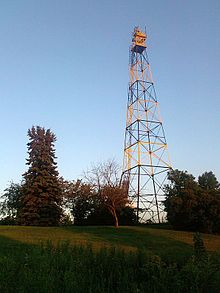Indian Mounds Regional Park (Saint Paul, Minnesota)
The oldest mounds were constructed about 2,500 years ago by local Indigenous people linked to the Archaic period, who may have been inspired by the burial style known as the Hopewell Tradition.
Typically, burial mounds and scaffolds were built on high locations in sight of related nearby villages that were near fresh water.
[11] Grave goods included mussel shells in the simplest and most common burials, and projectile points, perforated bear teeth, and copper ornaments in others.
[11] Human remains in funeral bundles found in the upper parts of some mounds have been interpreted as secondary burials from more recent periods.
[11] The early Antiquarian archeologists exhumed around 20 mostly complete skeletons (though many were missing their skulls) and fragments of perhaps another 30, but they did not screen soil and noted that they returned skeletal remains to their backfilled trenches.
[4] In the late 19th century, the bluff-face was gradually demolished to widen the rail yard at its foot, destroying several mounds as well as the outer chamber of Carver's Cave.
Later, paths were removed from mounds and soil added to damaged areas, and in 1914 a still-standing brick pavilion was built to house a refreshment stand, restrooms, and space for open-air concerts.
[10] Indian Mounds Regional Park underwent a major restoration in the 1980s using state and federal funds for developing the Great River Road.
Restored to its historical black and chrome-yellow color scheme in the mid-1990s, the Indian Mounds Park beacon has been kept operational and flashes its rotating light every five seconds.
[14] It is one of the few remaining airway beacons in the U.S.[10][14] Indian Mounds Regional Park has two electrified picnic shelters that private groups can rent.
Other visitor amenities include a playground, barbecue grills, fire rings, restrooms, a drinking fountain, paved trails, a ball field, and tennis courts.

